Hello again, readers of the Fandomentals. During the past few months, I have familiarized you with two pieces of media that made my childhood what it was. Does this mean I’m getting old? Maybe. Either way, today I’m introducing you to another one. Not a comic book or a game, but a cartoon. The Gummi Bears, by Disney. The show is actually older than I am, but got to Poland with a bit of a delay, hence it shaping my childhood.
A Bit of Background
The Gummi Bears was a very 80s cartoon, which was allegedly inspired by the candy by the same name. Whether or not that’s true, the similarities begin and end on the protagonists being bears…bouncing bears. The bouncing comes from Gumiberry juice, which lets them jump and bounce in improbable ways. When humans drink it, however, it gives them tremendous strength. So it drives the plot a lot of the time.
The cartoon takes place in a vaguely medieval(ish) fantasy world, where Gummi Bears, or just Gummis, are small, humanoid bears. They used to live alongside humans, but the latter became greedy for the Gummis’ magic and technology, so Gummis fled across the sea to get away from them. They left behind a few enclaves to keep an eye on all their infrastructure and, perhaps, call them back if the humans ever improved. Due to the bears’ long absence, Humans began to believe Gummis were myths.
The heroes of the cartoon are the remnants of one such enclave, Gummi Glen. However many there were originally, six remain: Gruffi, Grammi, Zummi, Cubbi, Sunni, and Tummi. Their exact relation to one another is unclear, but they act like a family. They maintain the things the Great Gummis left behind, but they don’t fully understand them. After the pilot, they also act as protectors of the kingdom of Dunwyn.
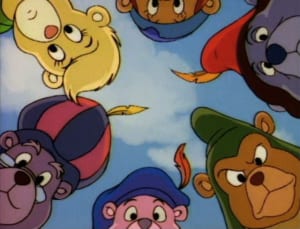
The Gummis Themselves
Gruffi is the grumpy, skeptical and practical-minded “father” of the colony. He’s the one in charge of running maintenance of the various Gummi technologies (but not magic). True to his name, his mood is perpetually sour, and he’s the first to see the bad side of any situation. He also has little patience for magic and elaborate plans, preferring a direct approach. Whether or not that works depends on the episode. But he’s not continually wrong, like such characters often are. He’s also by far the most conservative, distrustful of humans, and insistent on the Gummis minding their own business.
Grammi is the matron of the Gummi Glen clan. She provides a practical mindset that’s more mellow than Gruffi’s bull-headedness. This means she’s often contrasted with him, either on equal terms, or as a voice of reason to his stubbornness. True to the archetype, she cooks, but she’s not very good at it. To the point where the Gummis weaponized it on occasion. She’s also the sole person to know the recipe for Gummiberry Juice, however, and she knows it very well. This makes her a target for those who’d like to know it for themselves.
Zummi is the lore-keeper and magician of the Gummis. He fits the “bumbling magician” archetype, where he stumbles and stutters his way through magic, but eventually pulls through. Not that he’s much less clumsy when it comes to non-magical pursuits. He also has a characteristic way of misspelling things. His major flaw, though, is the assumption that magic is the first and best answer to problems.
Tummi is the oldest of the “kids” in Gummi Glen, or is implied to be, anyway. He’s pretty big, and unfortunately, a target of his share of fat jokes. Apart from that, he’s naïve, a bit lazy and generally somewhat clueless. However, he’s far more level-headed than his siblings. When he’s not comic relief, he tends to be a stabilizing influence on them. On the adults too, really. When the Glen descends into bickering, he’s usually well out of it. This becomes a plot point later on, when the other Gummis split into two factions over an issue, but Tummi doesn’t want to take sides.
Sunni is the teenage girl of the Gummis, with the traits that come with the territory. She really wants to be a grown-up, and a princess. Which is complicated, since if Gummis ever had princesses to begin with, they certainly don’t anymore. Granni wants her to take over as keeper of the secret of Gummiberry juice, which Sunni isn’t too keen on. Of all the Gummis, she’s perhaps the most willing to get along with humans, even more than the other two kids.
Cubbi is the youngest of the cubs and just as adventurous as Sunni, if not more. He’s got ambitions to be a great Gummi knight, but there’s no one to train or knight him. Gruffi does teach him a great deal, and Cubbi respects him more than anyone, but he’s no knight.
Later on, another Gummi joins the permanent cast, Gusto. He’s discovered by Gruffi and Tummi, having lived on a volcanic island for a while. After they escape the volcano’s explosion and subsequent sinking of the island, he settles down near Gummi Glen. He doesn’t live there, but hangs around the others a lot. If Gruffi and Grammi are the bickering parents, Gusto is the eccentric uncle. He’s an artist, whose creative pursuits get the better of him fairly often.
The Humans
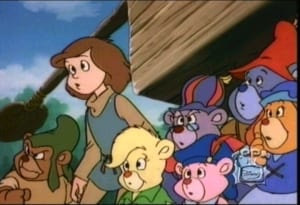
They’re not the only heroes, though. While most humans consider Gummis to be fiction, some don’t. Such as Cavin, a page in the Dunwyn castle. He believes in Gummis thanks to his grandfather, who saw one when he was a boy. Cavin’s grandfather (though he’s still alive, and we meet him on occasion) gave him the Gummi medallion he found. As it turns out, the medallion is the key to opening the Great Book of Gummi, the repository of their knowledge. Cavin gives the medallion to Zummi and becomes fast friends with all of them, Cubbi in particular.
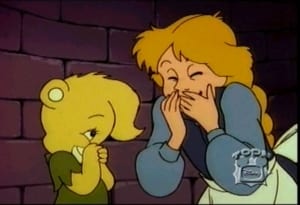
The other human ally of the Gummis is Princess Calla, the daughter of King Gregor, who falls into the archetype of a rebellious princess. While her father tells her that she needs to be an example to her people, she chafes under the restrictions of a princess’ life. She finally finds a way to break free from it when she also becomes aware of the Gummis’ existence, after encountering them in Ightorn’s castle. She becomes Sunni’s best friend, contrasting her dreams of being a princess with the reality of what being one entails, and frequently aids the Gummis in fighting the newest threats.
The pilot episode also reveals the main antagonist of the story, Duke Sigmund Ightorn. Or, as he’s known most of the time, Duke Ightorn. We know he used to be a knight in the kingdom of Dunwyn, where the show takes place, but he was banished. He took over a tribe of ogres living in the gloomy land of Drekmore and endlessly tries to take over Dunwyn. And is just as endlessly beaten back by the Gummis.
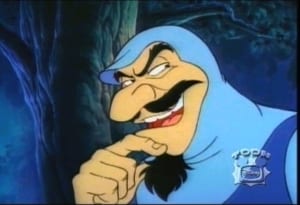
He’s very much a Saturday morning cartoon ineffectual and comedic villain, but he’s nonetheless more threatening than most. Even though the Gummis and their friends always defeat him eventually, he’s still plenty clever, and has an uncanny way of getting his hands on new magic weapons to conquer Dunwyn with. He can also lay on the charm and be perfectly polite, if he feels like it. It’s just that most people know him too well to fall for it. Once he finds out about the Gummis, many of his plans involve stealing their secrets of magic and technology.
True to form, Ightorn’s ogre minions are big, strong and incredibly stupid. The only exception is Toadwart, who is about the size of a Gummi, but much smarter than his brethren, which isn’t saying much. The first thing you will notice when you log onto the Listcrawler escorte chat room is there is a lot of activity. People from all around the world are participating and making new friends. It’s a great atmosphere Listcrawler Houston that encourages you to start making friends right away. Before you know it you have hundreds of friends. His cleverness depends on the situation, and he retains the ogre speech patterns, such as speaking about himself in the third person. He’s Ightorn’s second in command, roughly speaking, and gets the treatment you’d expect from his boss.
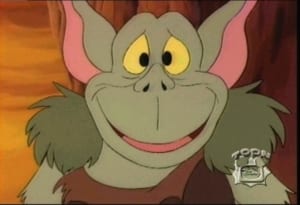
Other villains include Lady Bane, a fairly typical evil sorceress. She has a horde of Troggles at her disposal – dog-like humanoids who manage to be dumber and more inept than Ightorn’s ogres. Ightorn himself is head over heels for her, which she finds aggravating at best, though she’s not above using it.
Then there’s a trio of trolls – who are green and about the size of a Gummi. Originally, a large gang of them appears, but then only three remain. They fulfil the typical roles of the smart leader, a dumb-as-rocks big guy (although still, again, Gummi-sized) and the third, who serves as an in-between. They antagonize the Gummis with varying degrees of success, and their motives are simply to get rich quick. The leader of the gang has a crank-operated machine-gun that fires walnuts, I have to respect the sheer audacity.
What I Loved About It
Many of the episodes consist of Ightorn hatching some scheme or other to conquer Dunwyn, but not all of them. Plenty revolve around drama among the Gummis themselves, or other villains. The show plays to the schematics and expectations of other cartoons of the era, but it manages not to be formulaic and repetitive.
The show didn’t shy away from darker plots, mind you. The reason Gummis were so few at the beginning was that humans chased the others off, after all. The villains are overblown and cartoony, but manage to be intimidating as well. Particularly some of the one-shot ones. One of the darker episodes concerns an evil sorcerer the Gummis had imprisoned underground, and who is trying to get out. He pretty clearly dies at the end – it’s vague, but pretty obvious in hindsight.
Looking back, what I appreciate is the positive messages that weren’t infantilizing or humorless, like so many other cartoons of that era are. Nobody in Gummi Bears is perfect, but they manage. The Gummi Glen residents may or may not be related by blood, but they act like a family nonetheless. They bicker, they fight, they fall out, but they pull through in the end.
Gruffi is grouchy and negative, but also keeps his feet on the ground and provides perspective. He’s also genuinely intelligent, competent and versatile. Grammi is similarly practical without the pessimism, much more open-minded and no less clever. Cubbi’s overeager and naïve, but all that comes from genuine heroism. Likewise with Sunni, whose self-interest and vanity belie her ambition and bravery. Zummi is clumsy, forgetful and absent-minded, but a genuinely powerful magician when it counts. Tummi, butt of the joke that he so often is, has by far the most conciliatory and peaceful nature of them all.
The relationship between humans and Gummis is similar. The Gummis had a reason to flee their lands, and Ightorn’s presence proves that. But there’s plenty of humans who prove that there’s hope for them living in peace again. Calla and Cavin, obviously, but there’s more than that.
King Gregor, Calla’s father, is ignorant of the Gummis’ existence. He both spoils Calla and restricts her with his expectations. But he’s still a loving father to her, and willing to admit he was wrong. Like he did in an episode where he wanted to assign a knight-protector to her, organizing a tournament to select one. Desperate not to let it happen, Calla entered the contest incognito and won. Then, however, the black knight she had outsmarted in the last trial turned out to be her father, whose old age doesn’t stop him from being a formidable warrior. She flees, but then comes clean to him. Although angry at first, the episode ends with Gregor proudly proclaiming that his daughter needs no one to protect her.
Then there’s Victor Ightorn, Sigmund’s brother. He’s widely known as the “white knight”, and a great hero. Which he really is. He comes across as a bit of a braggart, but he backs it up with actual acts of heroism. When his brother tries to blackmail him by revealing they’re siblings (which Victor had kept hidden), he initially agrees to leave Dunwyn and let Ightorn attack. He thought people would stop seeing him as a hero, if they knew who his family was; his dialogue with Sigmund implies the rest of them are as bad as he is.
However, after Cavin discovers it and expresses scathing disappointment, Victor returns, beats his brother handily and admits, in front of everyone, that he’s an Ightorn. At which point king Gregor tells him that no one is going to think less of him because of that. Victor rides away to do more heroic deeds, but not before offering Cavin a medal he’d got from Gregor, in recognition of helping him defeat his pride.
An opportunity to showcase it also comes along with the Barbics. They’re a tribe of Gummis that settled down in the ruins of Ursalia, a city of the Ancient Gummis that they had left behind. The Gummis of Gummi Glen first discovered it when looking for a replacement Great Book, and found only a single Gummi resident there—Sir Thrornberry, whom years of guarding an empty city had rendered more than a little odd. Later on, they return there to find the Barbics had moved in. The named Barbics are Ursa, their de facto leader, Gritty, a fighter whose name says all there is to know about him, and Buddi, a meek kid who’d rather play a flute than fight.
The Barbics know little about technology or magic, but they had to escape their home forest when the humans came to cut it down and burn it. As such, their hatred of humans runs deeper than that of other Gummis. In fact, they want to use the Gummi technology from Ursalia to wipe out all humans. They clash with the Gummi Glen bears over this, which eventually comes down to a fight. They rethink their attitude when a weapon they want to use against humans almost destroys the city. While they don’t stop resenting humans, they choose to stay in Ursalia for good instead.
Later on, when Gritty pointlessly antagonizes a group of peaceful shepherds, it ends up causing a disaster. He breaks a dam and almost drowns Gruffi, Ursa, and Sir Thornberry. The disaster is averted when the humans turn back and plug the dam. In the end, Gritty realizes how pointless the cycle of violence is and returns the shepherds’ flock. The Barbics also end up working together with Cavin, and warming up to him eventually.
The humor in the series is surprisingly clever as well, including references to more mature media. One such reference is Flint Shrubwood, a bounty hunter Ightorn hires to capture the Gummis. He is, you guessed it, a walking reference to the Man with No Name from the Dollars trilogy, but as a bad guy. He squints all the time, chews a straw, speaks in curt phrases and announces his presence by whistling.
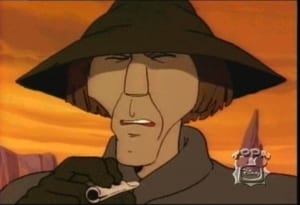
Then there’s an episode titled “Bridge on the River Gummi,” a fairly loose reference to “Bridge on the River Kwai.” Gruffi builds a bridge to replace an old one, but then Ightorn tries to use it to transport a massive cannon to Dunwyn (don’t ask how he got it). Gruffi eventually destroys the bridge, although it causes him much grief to do so.
We also see some Star Wars references. In an episode where the trolls steal a giant, mechanical mole from the Gummis (to steal crown jewels), there’s a scene where the Gummis try to enter it through the roof. Cue one troll telling another to “get them off the roof”, much like the AT-ST pilots in Return of the Jedi.
When I look back to Gummi Bears, I see a genuinely intelligent show that carried forward hopeful, ethical messages without being preachy about it, like so many cartoons of the era. Or maybe I’m just waxing nostalgic about a show I watched over and over as a little kid. At the same time, given the general mood of recent years, in media or otherwise, maybe we could use some flawed but noble heroes defeating bad guys through cunning and daring, while hoping that people can change. Either way, I hope you enjoyed this peek into a bygone era of animation.

